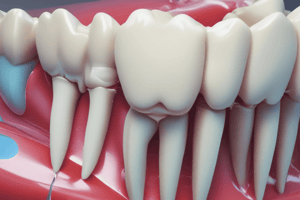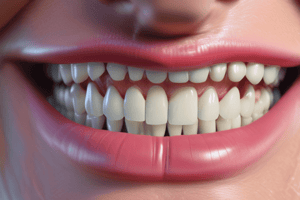Podcast
Questions and Answers
What is the primary mineral content found in enamel rods?
What is the primary mineral content found in enamel rods?
- Calcium carbonate
- Calcium fluorapatite
- Calcium hydroxyapatite (correct)
- Calcium phosphate
What is the shape of the cross-section of enamel rods?
What is the shape of the cross-section of enamel rods?
- Circular
- Square
- Keyhole (correct)
- Triangular
What part of the tooth do the heads of the enamel rods typically face?
What part of the tooth do the heads of the enamel rods typically face?
- Dento-enamel junction
- Root surface
- Occlusal/incisal surface (correct)
- Cervical region
How do the orientations of the crystallites within the enamel rods differ between the head and the tail?
How do the orientations of the crystallites within the enamel rods differ between the head and the tail?
Which feature surrounds each rod and interrod in enamel?
Which feature surrounds each rod and interrod in enamel?
Where is the enamel thickest in relation to the structure of the tooth?
Where is the enamel thickest in relation to the structure of the tooth?
What is the primary function of the incremental lines observed in enamel?
What is the primary function of the incremental lines observed in enamel?
How does the direction of enamel rods vary across the tooth structure?
How does the direction of enamel rods vary across the tooth structure?
What does a radiolucent area of enamel indicate in a radiographic view?
What does a radiolucent area of enamel indicate in a radiographic view?
Which structural abnormality is represented by the neonatal line in enamel?
Which structural abnormality is represented by the neonatal line in enamel?
What is a potential consequence of systemic disturbances during amelogenesis?
What is a potential consequence of systemic disturbances during amelogenesis?
What are incremental lines in enamel indicative of?
What are incremental lines in enamel indicative of?
Which of the following factors can cause genetic enamel defects?
Which of the following factors can cause genetic enamel defects?
How can nutritional deficiencies during enamel formation affect teeth?
How can nutritional deficiencies during enamel formation affect teeth?
What is the clinical significance of the difference in lesion size between enamel and dentine?
What is the clinical significance of the difference in lesion size between enamel and dentine?
Which of the following is an example of a local disturbance impacting enamel formation?
Which of the following is an example of a local disturbance impacting enamel formation?
What is the primary mineral content of enamel?
What is the primary mineral content of enamel?
Which of the following best describes the organic content of enamel?
Which of the following best describes the organic content of enamel?
How does the structure of enamel relate to its function?
How does the structure of enamel relate to its function?
What is the embryonic origin of enamel?
What is the embryonic origin of enamel?
What percentage of enamel is composed of inorganic minerals?
What percentage of enamel is composed of inorganic minerals?
Which of the following is not a component of enamel composition?
Which of the following is not a component of enamel composition?
What clinical significance does enamel have in health?
What clinical significance does enamel have in health?
Which statement regarding the aging of enamel is incorrect?
Which statement regarding the aging of enamel is incorrect?
What are enamel spindles primarily considered to be?
What are enamel spindles primarily considered to be?
What do Hunter Schreger Bands represent?
What do Hunter Schreger Bands represent?
What is the main function of enamel?
What is the main function of enamel?
What causes enamel lamellae?
What causes enamel lamellae?
What best describes the mineral composition of enamel?
What best describes the mineral composition of enamel?
What is a significant change that occurs to enamel over time?
What is a significant change that occurs to enamel over time?
How does enamel's inability to repair itself manifest?
How does enamel's inability to repair itself manifest?
What is the role of micropores in enamel structure?
What is the role of micropores in enamel structure?
What structural characteristic of enamel rods helps to enhance the overall strength of enamel?
What structural characteristic of enamel rods helps to enhance the overall strength of enamel?
Why is the direction of enamel rods important in cavity preparation?
Why is the direction of enamel rods important in cavity preparation?
Which of the following describes the lifecycle of ameloblasts?
Which of the following describes the lifecycle of ameloblasts?
What are Stria of Retzius?
What are Stria of Retzius?
What is the role of Perkymata in enamel?
What is the role of Perkymata in enamel?
What phase of amelogenesis results in the formation of incremental lines?
What phase of amelogenesis results in the formation of incremental lines?
What happens to Perkymata over time?
What happens to Perkymata over time?
What is the significance of the S-shape bending of enamel rods?
What is the significance of the S-shape bending of enamel rods?
Flashcards are hidden until you start studying
Study Notes
Composition and Structure of Enamel
- Enamel is the hardest tissue in the human body
- Enamel is made up of 96% inorganic minerals, primarily calcium hydroxyapatite, with small amounts of carbonate and fluoride
- Enamel's organic content comprises 4% fibrous material (collagen), some water, and proteins
Structure of Enamel
- Enamel rods (prisms): Millions of tightly packed enamel rods form the structure of enamel. They have a keyhole shape in cross-section.
- Interrods: The tail of the enamel rod is referred to as an interrod.
- Crystallites: Each rod contains millions of calcium hydroxyapatite crystallites, which are long, thin, and ribbon-like.
- Incremental lines: The pattern of amelogenesis, the process of enamel formation, results in visible incremental lines.
- Stria of Retzius: Lines representing enamel growth during active and resting phases.
- Perkymata: Shallow furrows on the enamel surface where the incremental lines reach the surface.
- Prismless enamel: Enamel without visible rods.
Enamel at the DEJ
- Dento-enamel junction (DEJ): The boundary between enamel and dentine.
- Enamel spindles: Extensions of dentinal tubules into enamel.
- Hunter-Schreger bands: Light and dark bands visible under a microscope, appearing as growth rings in cross-sections.
- Lamella: Cracks in enamel that can extend inward toward the DEJ, potentially mistaken for cracks in enamel.
Function of Enamel
- Protection: Enamel shields the tooth and the dental pulp from injury.
- Eating: Enhances chewing and biting.
- Inability to repair or feel injury: Enamel is an inert tissue without living cells, making it unable to repair itself.
- Ion exchange: Enamel is permeable, allowing for remineralization and demineralization.
- Aesthetics: Enamel's translucency contributes to the 'pearly white' appearance of teeth.
Clinical Significance of Enamel Changes
- Attrition: Normal wear and tear on enamel due to chewing.
- Abrasion: Enamel wear caused by abrasive agents such as toothbrushes or toothpastes.
- Erosion: Loss of enamel due to acidic substances.
Enamel Structural Abnormalities
- Neo-natal line: A prominent line marking the change in enamel formation before and after birth.
- Exaggerated Incremental lines: Lines that can result from systemic disturbances during amelogenesis (e.g., fever, tetracycline exposure).
- Local disturbances: Trauma can affect enamel formation in individual teeth.
- Systemic disturbances: Conditions such as fluorosis, tetracycline staining, nutritional deficiencies, and molar-incisor hypomineralization can impact the enamel of all teeth forming at the time of the disturbance.
- Genetic factors: Conditions like amelogenesis imperfecta affect the formation of enamel in all teeth.
Studying That Suits You
Use AI to generate personalized quizzes and flashcards to suit your learning preferences.




